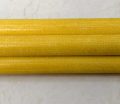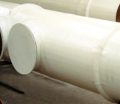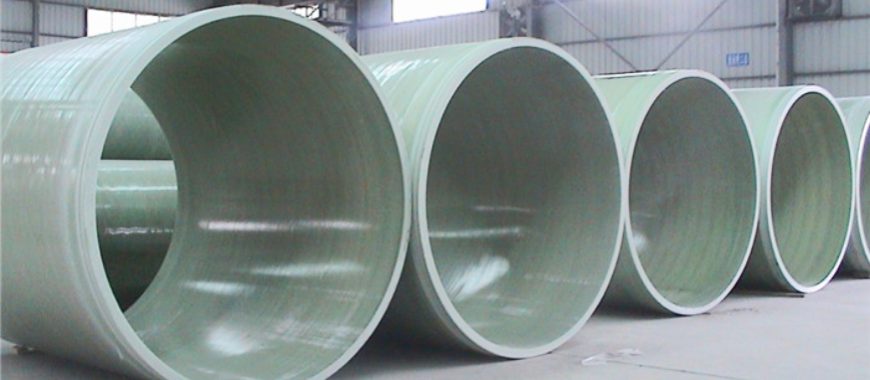
FRP pipe roughness factor plays a critical role in determining the efficiency of fluid flow through pipelines. FRP pipe roughness factor is typically very low, their smooth interior surfaces in the range of 0.0015 to 0.005 inches (0.038-0.127mm). The frp pipe roughness factor table provides essential data for engineers, helping to calculate and assess how surface roughness affects pressure loss and energy consumption. For FRP pipes, the absolute roughness is typically lower than that of traditional materials like steel, which results in smoother internal surfaces, reducing friction and allowing for more efficient fluid transportation. By comparing the FRP pipe roughness factor with other materials, such as PVC, HDPE, and steel, engineers can explore options like HDPE vs FRP pipe to optimize pipeline designs, ensuring better hydraulic performance and reduced operational costs. Understanding this factor is essential for industries relying on efficient pipeline systems.
What is FRP Pipe Roughness Factor?
The frp pipe roughness factor refers to the measurement of the internal surface texture of Fiberglass Reinforced Plastic (FRP) pipes. This factor is critical in understanding how fluids behave when transported through pipelines. Specifically, it measures how rough or smooth the interior surface of a pipe is, which directly affects the flow efficiency, friction loss, and energy consumption in fluid transport systems. FRP pipe is used in various industries due to their corrosion resistance, lightweight characteristics, and ability to handle a variety of fluids. Knowing the frp pipe roughness factor helps engineers and pipeline designers make informed decisions regarding hydraulic efficiency and the overall performance of a fluid transport system.
FRP Pipe Roughness Factor Formula
The frp pipe roughness factor formula plays a significant role in hydraulic calculations. The formula typically involves variables such as the internal diameter of the pipe, the velocity of the fluid, and the absolute roughness of the pipe material. This roughness, denoted as “ε,” represents the average height of surface irregularities inside the pipe.
The Darcy-Weisbach equation is often used to calculate friction loss in a pipe, where the frp pipe roughness factor is a key variable:
hf=f⋅L/D⋅V2/2g
Where:
g: Gravitational acceleration (9.81 m/S2).
hf: Head loss due to friction (m),
f: Darcy friction factor (dimensionless),
L: Pipe length (m),
D: Pipe diameter (m),
v: Fluid velocity (m/s),
The result gives the relative roughness, which directly impacts how much energy is required to move fluids through the pipeline. By understanding the frp pipe roughness factor formula, engineers can predict friction losses and design more efficient systems for fluid transportation.
Factors Influencing the FRP Pipe Roughness Factor
The roughness factor of FRP pipes is a critical parameter that affects fluid flow efficiency, pressure drop, and overall system performance. Several factors influence the roughness of these pipes, which can be categorized into material properties, manufacturing processes, and operational conditions:
Material Composition
- Resin Type: The type of resin used in the FRP pipe, such as polyester, vinyl ester, or epoxy, affects the smoothness of the inner surface. Epoxy resins typically provide a smoother finish compared to polyester.
- Fiberglass Content: A higher glass content can result in smoother surfaces as the structural integrity reduces imperfections.
- Fillers and Additives: Fillers can sometimes create a slightly rougher surface if not uniformly distributed.
Manufacturing Process
- Molding Techniques: Processes like filament winding, centrifugal casting, and hand lay-up yield different surface finishes. Filament winding and centrifugal casting generally produce smoother interiors compared to hand lay-up.
- Curing Conditions: Proper curing of the resin ensures minimal shrinkage and fewer surface irregularities. Poor curing can lead to rough patches or an uneven surface.
- Post-processing: Sanding, polishing, or coating the interior can significantly reduce roughness.
Pipe Aging and Wear
- Chemical Degradation: Exposure to harsh chemicals can erode the pipe surface over time, increasing roughness.
- Abrasive Fluids: Fluids containing solid particles can wear down the inner surface, making it rougher.
- UV Exposure: Prolonged exposure to UV radiation can degrade the resin matrix, affecting surface smoothness.
Operational Factors
- Flow Conditions: High-velocity fluids can lead to surface wear and pitting, especially if cavitation occurs.
- Temperature Fluctuations: Thermal cycling may cause minor surface cracking or deformation, impacting roughness.
- Pressure Variations: Stress from fluctuating pressures can result in micro-cracks, altering the surface profile.
Installation and Handling
- Improper Installation: Scratches or dents caused during installation can increase surface roughness.
- Mechanical Damage: Handling damage, such as impact or abrasions, can affect the pipe’s internal finish.
Quality Control
- Surface Inspection: Quality control during manufacturing ensures consistent surface smoothness. Pipes with poor inspection protocols may exhibit higher roughness variability.
- Standards Compliance: Pipes manufactured to stringent industry standards (e.g., ASTM or ISO) are likely to have more uniform and lower roughness factors.
Environmental Factors
- Contaminants: Accumulation of debris, biological growth (e.g., biofouling), or chemical residues can alter the effective roughness of the pipe.
- Moisture Absorption: Certain resins may absorb moisture over time, affecting the smoothness and structural properties of the pipe.
The roughness factor of FRP pipes is influenced by a combination of material characteristics, manufacturing precision, and external operational factors. To minimize roughness and maintain flow efficiency, careful selection of materials, adherence to high manufacturing standards, and proper maintenance practices are essential. These considerations ensure the long-term performance and reliability of FRP piping systems in various industrial applications.
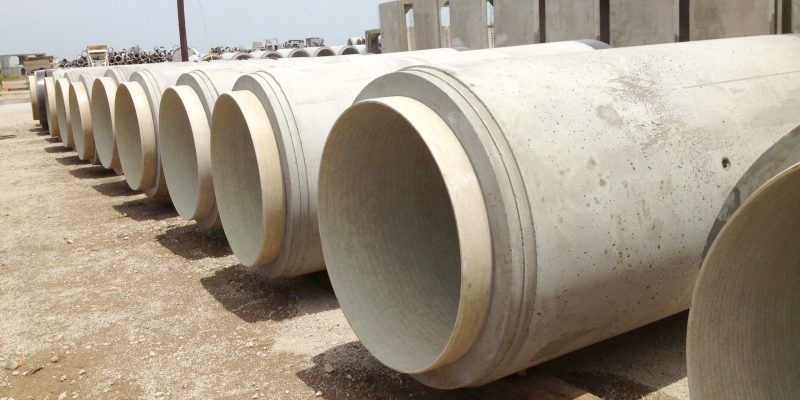
Absolute and Relative FRP Pipe Roughness Factor
The roughness factor of FRP (Fiberglass Reinforced Plastic) pipes is critical for determining flow characteristics, such as friction losses and pressure drop, in fluid systems. These factors are typically categorized as absolute roughness and relative roughness.
Absolute Roughness Factor
Definition:
Absolute roughness (ϵ\epsilonϵ) is a measure of the average height of irregularities on the internal surface of a pipe. It is expressed in units of length, typically millimeters (mm) or feet (ft).
Characteristics for FRP Pipes:
- FRP pipes typically have a low absolute roughness compared to metallic pipes like steel or cast iron. This is due to their smooth, resin-based internal surface.
- Typical values range between 0.00015 ft (0.045 mm) and 0.0006 ft (0.18 mm) depending on the manufacturing process and resin composition.
- Over time, factors such as wear, abrasion, or chemical exposure may increase the absolute roughness.
Importance:
- Used directly in the Darcy-Weisbach equation to calculate pressure drop in a pipeline.
- Lower absolute roughness means reduced friction losses, making FRP pipes more energy-efficient for transporting fluids.
Relative Roughness Factor
Definition:
Relative roughness (ϵ/D) is the ratio of the absolute roughness (ϵ\epsilonϵ) to the internal diameter (D) of the pipe. It is a dimensionless value used to assess the effect of surface roughness in relation to pipe size.Relative Roughness=ϵ/D
Characteristics for FRP Pipes:
- For large-diameter FRP pipes, the relative roughness tends to be smaller because the pipe diameter (D) dominates the ratio.
- Small-diameter pipes may have a higher relative roughness even if the absolute roughness remains constant.
- Typical relative roughness for FRP pipes is 0.0005 to 0.002, depending on the application and condition of the pipe.
Importance:
- It is critical for determining the flow regime (laminar, transitional, or turbulent) using the Moody Diagram.
- Helps predict flow resistance and is essential for designing efficient fluid systems.
| Aspect | Absolute Roughness | Relative Roughness |
|---|---|---|
| Definition | Physical height of surface irregularities | Ratio of roughness to pipe diameter |
| Units | mm, ft, or equivalent length units | Dimensionless |
| Dependent On | Material, manufacturing, and aging | Absolute roughness and pipe diameter |
| Application | Direct input for friction factor | Evaluates flow impact in Moody chart |
| FRP Typical Range | 0.045 mm to 0.18 mm | 0.0005 to 0.002 |
Advantages of Low Roughness in FRP Pipes
- Energy Efficiency: Smooth surfaces reduce energy losses due to friction.
- Lower Maintenance: Less prone to clogging or fouling compared to rougher materials.
- Durability: Resistance to corrosion and chemical degradation ensures roughness remains stable over time.
Both absolute and relative roughness factors is crucial for engineers when selecting FRP pipes for applications in water supply, chemical processing, and industrial piping systems.
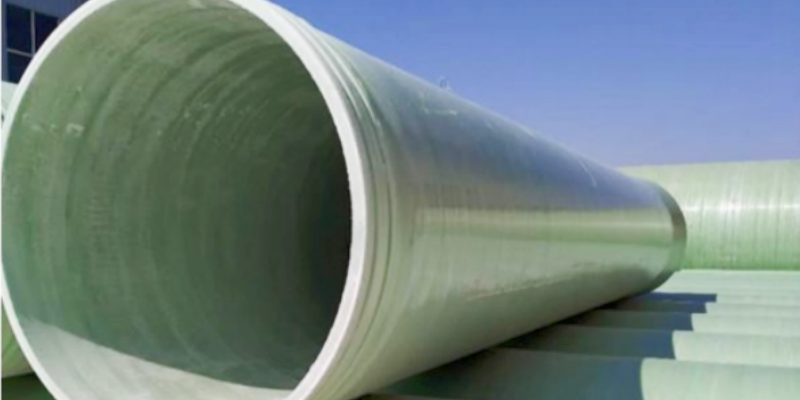
Different Materials FRP Pipe Roughness Factor
FRP (Fiberglass Reinforced Plastic) pipes are manufactured using various resin systems and fiberglass configurations, which influence their roughness. Below is a breakdown of the roughness factors for pipes made from different materials:
Polyester Resin-Based FRP Pipes
Polyester resin is widely used due to its cost-effectiveness and moderate chemical resistance.
- Absolute Roughness (ϵ\epsilonϵ): Typically 0.0004 ft (0.12 mm).
- Characteristics: These pipes have smooth internal surfaces, although slightly rougher compared to epoxy-based FRP. Over time, they may degrade under exposure to strong acids or alkalis, increasing surface roughness.
- Applications: Suitable for general-purpose piping, water transport, and cost-sensitive industrial systems.
Vinyl Ester Resin-Based FRP Pipes
Vinyl ester resin provides enhanced chemical resistance and durability compared to polyester.
- Absolute Roughness (ϵ\epsilonϵ): Typically 0.00035 ft (0.11 mm).
- Characteristics: These pipes are smoother than polyester-based alternatives and maintain low roughness over time due to their superior chemical and wear resistance.
- Applications: Commonly used in chemical processing, wastewater treatment, and systems transporting corrosive fluids.
Epoxy Resin-Based FRP Pipes
Epoxy resin is a premium material offering exceptional mechanical and thermal properties.
- Absolute Roughness (ϵ\epsilonϵ): Typically 0.00015 ft (0.045 mm).
- Characteristics: Known for their exceptionally smooth internal surfaces and long-term stability, these pipes are resistant to chemical degradation, thermal cycling, and wear.
- Applications: Ideal for high-pressure pipelines, oil and gas systems, and critical industrial operations.
Phenolic Resin-Based FRP Pipes
Phenolic resin is valued for its fire resistance and low smoke emission properties.
- Absolute Roughness (ϵ\epsilonϵ): Typically 0.0005 ft (0.15 mm).
- Characteristics: While fire-resistant, these pipes have slightly rougher surfaces than epoxy-based alternatives. Their chemical resistance is moderate.
- Applications: Common in fire protection systems, marine environments, and areas requiring low smoke and toxicity.
Dual-Laminate FRP Pipes
Dual-laminate FRP pipes feature a thermoplastic liner (e.g., PVC, CPVC, or PVDF) combined with an FRP structural layer for added chemical resistance.
- Absolute Roughness (ϵ\epsilonϵ): Typically 0.0002–0.0003 ft (0.06–0.09 mm).
- Characteristics: These pipes have extremely smooth internal surfaces due to the thermoplastic liner, which also provides excellent resistance to chemical attack and wear.
- Applications: Used for aggressive chemical handling, high-purity systems, and specialized industrial processes.
The material used in FRP pipes significantly affects the roughness factor, influencing fluid flow efficiency and system performance. Epoxy resin FRP pipes provide the smoothest surfaces, making them suitable for high-performance systems, while dual-laminate pipes are preferred for extreme chemical resistance. Proper material selection is key to ensuring efficiency, durability, and cost-effectiveness in piping systems.
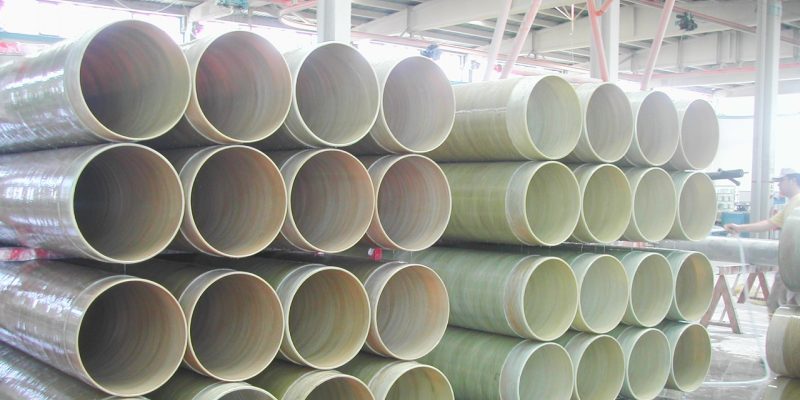
Importance of FRP Pipe Roughness Factor in Pipeline Design
The FRP pipe roughness factor is essential in pipeline design, particularly for pre insulated FRP pipe, as it influences the pressure loss and energy efficiency of fluid transport systems. Engineers must consider the roughness factor when selecting the pipe diameter, pump size, and flow rate. A lower frp pipe roughness factor indicates smoother internal walls, which means less friction and pressure loss as fluids move through the pipeline.
In pipelines with a high roughness factor, more energy is required to maintain fluid flow, leading to increased operational costs. This is particularly important in large-scale industrial operations, where energy efficiency can significantly impact profitability. Therefore, the frp pipe roughness factor is a key consideration when designing systems that aim to optimize fluid transport while minimizing energy consumption and maintenance requirements.
How FRP Pipe Roughness Factor Affects Hydraulic Performance
The hydraulic performance of a pipeline system is heavily influenced by the frp pipe roughness factor. In pipelines with a lower roughness factor, the fluid moves more smoothly with less resistance, resulting in a lower pressure drop along the pipe’s length. This means that less energy is required to maintain a constant flow rate, improving the overall efficiency of the system.
In contrast, a higher frp pipe roughness factor results in increased turbulence and friction, causing more significant pressure losses. Engineers must account for these factors when calculating the required pump size and power to ensure the system operates efficiently. Understanding the frp pipe roughness factor allows for precise calculations, helping to avoid the oversizing of pumps or undersizing of pipes, which can lead to unnecessary energy costs.
Maintenance Considerations for FRP Pipe Roughness Factor
Maintaining the frp pipe roughness factor over time is crucial for ensuring the longevity and performance of a pipeline system. Unlike metal pipes that can corrode and increase in roughness over time, FRP pipes are more resistant to environmental factors, ensuring that their internal smoothness remains stable. This stability helps maintain consistent fluid dynamics and reduces the need for frequent maintenance.
However, regular inspections are still necessary to monitor the condition of the pipes and detect any changes in the frp pipe roughness factor. Over time, factors such as fluid abrasion, chemical exposure, and temperature fluctuations can affect the internal surface of the pipe. By regularly assessing the frp pipe roughness factor, maintenance teams can determine if any interventions are needed to restore the pipe’s performance, such as cleaning or relining the internal surface.
GangLong Fiberglass provides maintenance guidelines for its FRP pipes, emphasizing the importance of regular inspections to ensure optimal performance. These guidelines often include recommendations for monitoring the FRP pipe roughness factor to detect any potential issues that could impact the efficiency of the fluid transport system, which can also affect FRP pipe tensile strength. Maintaining optimal conditions is crucial for ensuring the structural integrity and performance of the piping system.
Know FRP’s Coefficient of Thermal Expansion
Applications of FRP Pipes and Their Roughness Factor
FRP pipes are widely used across industries such as chemical processing, water treatment, and waste management. In these applications, the FRP pipe roughness factor plays a critical role in ensuring the efficient flow of fluids, closely related to the FRP pipe friction factor. Together, these factors influence flow rates and pressure losses, making it essential to optimize both for effective piping system performance, particularly when considering the ID of FRP Pipe. A well-calibrated roughness factor in relation to the internal diameter can significantly affect flow rates and pressure drops, making it essential for optimal system performance. The low roughness factor of FRP pipes contributes to their popularity in industries where smooth fluid flow and minimal friction loss are essential for maintaining system efficiency.
For example, in chemical plants where corrosive materials are frequently transported, the frp pipe roughness factor helps to ensure that these materials flow smoothly through the system without excessive friction or pressure loss. Similarly, in water treatment facilities, FRP pipes with a low roughness factor help to minimize energy consumption by reducing the resistance encountered by the water as it moves through the pipes.
Wastewater treatment plants also benefit from the frp pipe roughness factor, as it helps to ensure that waste moves efficiently through the system without causing blockages or excessive wear on the pipes. GangLong Fiberglass produces FRP pipes designed for such high-performance applications, with a consistent and low roughness factor that ensures minimal friction loss even in demanding environments.
Long-Term Benefits of a Low FRP Pipe Roughness Factor
Choosing FRP pipes with a low roughness factor provides several long-term benefits for pipeline systems. First and foremost, a lower frp pipe roughness factor results in less energy consumption due to reduced friction between the fluid and the pipe walls. This leads to lower operational costs over the lifetime of the pipeline.
Additionally, pipes with a lower roughness factor are less prone to the buildup of sediment or other materials, which can further reduce the efficiency of the system. This means that FRP pipes require less frequent cleaning and maintenance, saving both time and money for operators.
GangLong Fiberglass produces FRP pipes that maintain a low frp pipe roughness factor throughout their lifespan, ensuring consistent performance and minimal maintenance requirements. By choosing pipes with a low roughness factor, operators can enjoy long-term savings and improved system efficiency.
How to Calculate the FRP Pipe Roughness Factor
Calculating the frp pipe roughness factor is a crucial step in designing an efficient pipeline system. Engineers often use roughness tables and hydraulic equations, such as the Darcy-Weisbach equation, to calculate the friction loss in a pipeline.
First, the absolute roughness of the FRP pipe is determined based on its material and manufacturing process. This value is then used in conjunction with the pipe’s diameter and the fluid velocity to calculate the relative roughness, which is used in hydraulic calculations to determine friction loss.
GangLong Fiberglass provides technical documentation with specific roughness values for its FRP pipes, making it easy for engineers to calculate the frp pipe roughness factor and design pipelines that meet the required performance standards. These roughness values are typically included in hydraulic design software, allowing for precise calculations that help optimize fluid transport systems.
The Future of FRP Pipe Roughness Factor in Industrial Applications
As technology continues to advance, the frp pipe roughness factor is expected to improve even further, leading to more efficient and durable pipeline systems. Manufacturers like GangLong Fiberglass are continuously researching ways to reduce the roughness factor of their FRP pipes through innovations in resin technology and fiber reinforcement.
In addition, advancements in hydraulic design software are making it easier for engineers to accurately calculate the frp pipe roughness factor and design systems that maximize efficiency and reduce energy consumption. These developments will help ensure that FRP pipes remain a popular choice for fluid transport systems across a range of industries.
In the coming years, it is likely that FRP pipes with even lower roughness factors will become available, providing operators with even greater energy savings and improved system performance. By staying at the forefront of these advancements, GangLong Fiberglass is committed to providing high-quality FRP pipes that meet the evolving needs of the industry.
Applications of FRP Pipe Wet Layup in Industrial Rehabilitation
What is the FRP Pipe Roughness Factor?
The FRP (Fiberglass Reinforced Plastic) pipe roughness factor is an important concept in fluid transportation systems, influencing the efficiency of fluid flow through a pipeline. The frp pipe roughness factor represents the texture or irregularities on the internal surface of the pipe, which can affect the amount of friction generated as fluids pass through. A smoother surface corresponds to a lower roughness factor, reducing friction and leading to more efficient fluid transport.Understanding and calculating the FRP pipe roughness factor is essential for engineers and designers when planning pipelines for industrial, chemical, or water management systems, especially in relation to FRP pipe temperature limits.
How the Manufacturing Process Affects the FRP Pipe Roughness Factor
The frp pipe roughness factor is directly influenced by the materials and processes used during manufacturing. FRP pipes are made by combining resin with glass fibers, which creates a strong, lightweight, and corrosion-resistant pipe. However, the internal surface of the pipe can vary in smoothness depending on how well the resin and fibers bond during production.
Manufacturers like GangLong Fiberglass use precise techniques to ensure that their FRP pipes have a smooth internal surface, resulting in a low frp pipe roughness factor. This is crucial for industries where fluid flow efficiency is paramount. The lower the roughness factor, the less energy is needed to move fluids through the pipe, leading to significant cost savings and enhanced performance in systems that rely on FRP pipes for transporting water, chemicals, or gases.
Top Challenges Contractors Face in Securing FRP Pipes Tenders
The Significance of the FRP Pipe Roughness Factor in Hydraulic Calculations
In hydraulic engineering, the frp pipe roughness factor plays a key role in calculating pressure loss due to friction. Engineers use the Darcy-Weisbach equation to determine how much pressure is required to move fluids through a pipe, and the roughness factor is a critical variable in this equation. A lower frp pipe roughness factor means less friction and therefore less pressure loss over a given length of pipe.
The frp pipe roughness factor is usually measured in millimeters or micrometers and represents the average height of surface irregularities inside the pipe. FRP pipes typically have a very low roughness factor, making them highly efficient for fluid transport. In applications such as chemical processing or water distribution, having a low frp pipe roughness factor can lead to substantial energy savings, as less force is required to maintain fluid flow at the desired rate.
The Key of FRP Pipe Roughness Factor in System Design
When designing a fluid transport system, the frp pipe roughness factor must be considered alongside other factors such as pipe diameter, fluid velocity, and pressure. The roughness factor influences the Reynolds number, a key figure in determining whether the fluid flow will be laminar or turbulent. A lower frp pipe roughness factor generally leads to laminar flow, which is smoother and more efficient.
In large-scale industrial applications, choosing FRP pipes with a known roughness factor helps designers optimize their systems for efficiency. By consulting roughness factor tables or specifications from manufacturers like GangLong Fiberglass, engineers can select the appropriate pipe sizes and materials for their projects. This ensures that the system operates effectively, whether it is transporting water over long distances or moving corrosive chemicals in a processing plant.
Maintenance Considerations for FRP Pipe Roughness Factor
Over time, the internal surface of pipes can degrade or accumulate debris, affecting the frp pipe roughness factor. In many cases, FRP pipes maintain their smoothness for extended periods because they resist corrosion and scaling. However, regular inspections are necessary to ensure that the roughness factor remains within acceptable limits.
Manufacturers like GangLong Fiberglass provide maintenance guidelines to help monitor the frp pipe roughness factor in their products. In some environments, routine cleaning may be required to prevent the buildup of deposits that could increase the roughness factor. Maintaining a low frp pipe roughness factor is essential for ensuring long-term system efficiency, reducing energy consumption, and preventing costly downtime.
How the FRP Pipe Roughness Factor Affects Flow Efficiency
The frp pipe roughness factor is a critical determinant of flow efficiency. A lower roughness factor results in less resistance to fluid movement, meaning less energy is required to maintain the desired flow rate. This is particularly important in industries where large volumes of fluid are transported, as even a small increase in friction can significantly affect energy usage.
In applications such as water treatment, chemical transport, and industrial fluid systems, using FRP pipes with a low frp pipe roughness factor ensures that the system operates efficiently. Companies like GangLong Fiberglass manufacture FRP pipes with consistently low roughness factors, helping industries optimize their fluid transport processes and reduce energy costs over time.
Importance of FRP Pipe Roughness Factor in High-Pressure Applications
The frp pipe roughness factor becomes even more crucial in high-pressure systems. As fluid pressure increases, any surface irregularities inside the pipe can cause turbulence, leading to higher friction losses. In such applications, FRP pipes with a low roughness factor help maintain smooth, laminar flow, reducing the risk of turbulence and ensuring efficient fluid transport.
For example, in chemical processing plants where aggressive or corrosive fluids are transported at high pressure, the frp pipe roughness factor must be carefully considered to avoid unnecessary energy loss or equipment wear. GangLong Fiberglass produces FRP pipes designed for high-performance applications, ensuring that the roughness factor remains low even in demanding environments.
Long-Term Performance of FRP Pipes and Roughness Factor
One of the main benefits of FRP pipes is their durability and long-term performance. Unlike materials such as steel, which may corrode and develop rough internal surfaces over time, FRP pipes maintain their smoothness and resist degradation. This means that the frp pipe roughness factor stays relatively constant, ensuring consistent flow efficiency throughout the pipe’s lifespan.
Maintaining a low frp pipe roughness factor over time reduces the need for frequent maintenance and repairs, making FRP pipes a cost-effective solution for fluid transport. Properly designed frp pipe racks can help support the pipes and minimize wear, ensuring that they remain in optimal condition throughout their service life. This combination of low roughness and effective support contributes to the overall efficiency and longevity of the fluid transport system. Systems using FRP pipes are less likely to suffer from flow disruptions due to increased friction, resulting in lower operational costs and improved reliability.
Cost Efficiency and the FRP Pipe Roughness Factor
The frp pipe roughness factor directly impacts the overall cost efficiency of a fluid transport system. Lower roughness factors reduce the energy needed to move fluids through the system, which can translate into significant cost savings, particularly in large-scale operations. The long-term performance of FRP pipes also contributes to cost efficiency, as their resistance to corrosion and wear minimizes the need for costly replacements or repairs.
Manufacturers like GangLong Fiberglass offer FRP pipes with low roughness factors, designed to optimize both performance and cost efficiency. By selecting pipes with a low frp pipe roughness factor, industries can improve their system’s energy efficiency and reduce operational costs, leading to better financial outcomes over time.
Pipe Roughness Coefficient Table
Pipe roughness coefficient tables are commonly used by engineers to compare the roughness values of different pipe materials. These tables help in calculating the friction losses that occur as fluids flow through pipes. For FRP pipes, the frp pipe roughness factor is generally lower compared to other materials, making them an attractive option for industries that prioritize energy efficiency and smooth fluid flow.
Manufacturers such as GangLong Fiberglass often provide detailed pipe roughness coefficient tables in their technical documentation to assist engineers and designers in selecting the right materials for their projects. These tables, available in PDF formats, are vital for hydraulic calculations, helping to determine the most efficient pipeline configurations for a variety of industrial applications.
FAQs about Frp Pipe Roughness Factor
Glass Reinforced Plastic (GRP) pipes, which are made from a combination of fiberglass and resin, have a low roughness factor, typically between 0.005 to 0.017 millimeters. This smooth internal surface helps reduce friction loss and ensures a consistent flow rate, making GRP pipes a preferred choice for applications in water distribution, sewage systems, and industrial processes. Additionally, GRP pipes offer excellent resistance to corrosion, chemicals, and environmental factors, which allows them to retain their smoothness and efficiency over long periods, even in harsh environments.
Fiberglass pipes, made from reinforced plastic materials, typically have a low absolute roughness. The absolute roughness of fiberglass pipes ranges between 0.005 to 0.015 millimeters, depending on the specific manufacturing process and application. These pipes are known for their durability and corrosion resistance, which contributes to maintaining their smooth internal surfaces over time. The low roughness factor is ideal for applications such as water treatment, chemical processing, and other industrial uses where efficient fluid flow and low friction losses are necessary.
Perfluoroalkoxy (PFA) pipes are known for their smooth internal surfaces, providing excellent flow characteristics. The roughness of PFA pipes is generally in the range of 0.0002 to 0.001 millimeters. This extremely low roughness value ensures that PFA pipes offer minimal resistance to fluid flow, which is particularly advantageous in industries requiring high-purity fluid transport, such as chemical processing and pharmaceutical manufacturing. Additionally, PFA pipes are highly resistant to chemicals and temperature variations, maintaining their smoothness and performance over a long lifespan.
The surface roughness of FRP (Fiber Reinforced Plastic) pipes is typically very low, ranging from 0.0015 to 0.005 inches (0.038 to 0.127 mm). This smooth surface is achieved due to the resin-rich liner, which reduces friction and prevents the build-up of deposits inside the pipe. The low roughness ensures efficient fluid flow with minimal resistance, making FRP pipes ideal for applications requiring low-pressure loss and high hydraulic performance. Compared to metal pipes, FRP pipes offer superior smoothness, durability, and resistance to corrosion, contributing to their growing popularity in industrial and municipal systems.
Plastic pipes, including materials like PVC, CPVC, and HDPE, have an exceptionally low roughness factor, typically in the range of 0.00005 to 0.0002 inches (0.0013 to 0.005 mm). This low value reflects their smooth inner surface, which significantly reduces frictional losses during fluid flow. The smoothness of plastic pipes helps to prevent scaling or clogging, ensuring consistent performance over time. These properties make plastic pipes a preferred choice for potable water systems, drainage, and chemical transport, where efficient flow and minimal energy loss are critical.
The coefficient of friction for FRP pipes is generally low, ranging from 0.1 to 0.15, depending on the type of resin used and the pipe’s surface finish. This value represents the smooth inner surface of FRP pipes, which minimizes friction losses and enhances flow efficiency. The resin-based liner also reduces the likelihood of scaling or fouling, maintaining low resistance throughout the pipe’s operational life. These characteristics make FRP pipes an excellent choice for industries where low-pressure loss and energy efficiency are critical, such as water treatment, chemical transport, and wastewater systems.
The average roughness of a pipe depends on its material. For smooth materials like plastic, the roughness is very low, around 0.00005 to 0.0002 inches (0.0013 to 0.005 mm). FRP pipes have roughness values between 0.0015 and 0.005 inches (0.038 to 0.127 mm). Metal pipes, such as steel, are rougher, with values ranging from 0.0018 to 0.02 inches (0.045 to 0.5 mm). This average roughness impacts fluid flow, with smoother materials offering less resistance, leading to higher efficiency and lower pressure drops compared to rougher materials.
The friction factor of plastic pipes varies depending on the flow regime but is typically in the range of 0.008 to 0.012 for fully developed turbulent flow. This value is calculated using the Darcy-Weisbach equation and reflects the smooth inner surface of plastic pipes. Due to their low roughness, plastic pipes exhibit minimal energy loss and are highly efficient for transporting fluids. Their low friction factor also contributes to reduced pumping costs, making them an ideal choice for water supply, irrigation, and industrial piping systems requiring high flow efficiency.
The roughness coefficient K, used in equations like Hazen-Williams, quantifies the resistance to fluid flow in a pipe. For smooth materials like plastic and FRP pipes, the coefficient is very low, typically ranging from 0.01 to 0.02. This indicates minimal energy loss due to friction, making these pipes highly efficient for fluid transport. In contrast, rougher materials like cast iron or steel have higher K values, which lead to greater pressure losses. The low roughness coefficient of plastic and FRP pipes ensures better hydraulic performance, reduced pumping costs, and long-term operational efficiency.

As the editor of GangLong Fiberglass, I have years of experience and in-depth research, focusing on cable tray products, fiberglass solutions, and grille systems. I incorporate years of industry insights and practical experience into every content, committed to promoting the progress of the industry. At GangLong Fiberglass, my commitment is reflected in every product, from innovative cable trays to durable fiberglass solutions and sturdy grille systems. As an authoritative voice in the industry, my goal is to provide valuable information to professionals and businesses and promote forward-looking solutions.

